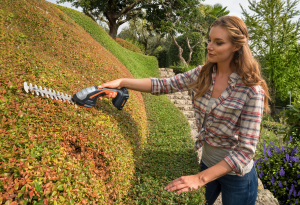How To Revitalize Overgrown Shrubs
Rejuvenating Overgrown Shrubs
Learn how to reign in overgrown shrubs and reinvigorate underperformers.
While regular pruning is the best way to keep plant size in check, sometimes we inherit an older landscape or let a plant slip through our radar. In some cases, older plants lose vigor and underperform in the landscape. These situations call for a heavy hand at pruning. There are two methods to revitalize weak and overgrown shrubs: rejuvenation pruning and renewal pruning.
Rejuvenation Pruning of Overgrown Shrubs
Rejuvenation pruning is a severe form of pruning often used to reinvigorate older shrubs that have become too large or contain a considerable amount of unproductive wood. The shrub is pruned by cutting off all or most of the branches near ground level.
Such heavy pruning stimulates an excessive number of new sprouts from the roots. This new growth will need to be thinned to reduce competition and maintain the natural form of the shrub. Maintain several strong, thick stems that contribute to the shape of the shrub, removing thin and weak shoots.
Use this method for revitalizing:
• Deciduous shrubs: abelia, barberry, red- and yellow-twig dogwood, flowering quince, forsythia, hydrangea, lilac, mockorange, privet, elderberry, spirea, and viburnum.
• Broadleaf Evergreens: camellia, mountain laurel (Kalmia), cherry laurel, holly
Renewal Pruning of Overgrown Shrubs
Renewal pruning reinvigorates older shrubs by pruning them back gradually over a three-year period. This method is used with shrubs that have few young, productive stems and plants that cannot tolerate the more severe form of rejuvenation pruning described above. It is also a good method to maintain flower production while gradually reducing the size of shrubs.
Renewal pruning is a three-year process in which one-third of the largest, oldest stems are removed each season by cutting them to ground level. By the third year, all of the oldest shoots have been removed and replaced by young, healthy stems. Pruning will stimulate new growth while maintaining the overall shape of the plant. Thin some of the new shoots to maintain the natural form of the plant and allow for good air circulation.
Use renewal pruning for:
• Abelia, Deutzia, Forsythia, Weigela, Mock orange, Kolkwitzia, Chokeberry, Dogwood, Kerria, Viburnum, and Witchhazel.
Pruning Overgrown Evergreen Shrubs
Few evergreen shrubs tolerate heavy pruning and overgrown plants can be a problem. Many needled evergreens like junipers have dead zones at their core and will not regenerate new growth from bare branches. Likewise, some broadleaf evergreens, like photinia and boxwood, may die or recover very slowly if pruned severely. Large, overgrown evergreen shrubs that do not tolerate heavy pruning will need to be removed and replaced with new shrubs.
Pruning Equipment
While loppers can be used to cut stems up to two inches in diameter, a hand saw or power saw is needed for larger stems. WORX JawSaw 5 Amp Electric Chainsaw is a great tool for cutting larger limbs up to 4 inches in diameter. Remember to scan the shrub before pruning for potential hazards, such as broken limbs or nearby electric wires. Protect yourself by using the proper personal protective gear.
When to Prune Overgrown Shrubs
Rejuvenation and renewal pruning are best done in late winter or early spring before buds break. Follow up early in the season with thinning of new growth. One revitalized, regular pruning will keep plants healthy and productive. Time annual maintenance pruning according to plant type and flowering time. As a rule of thumb, prune plants that bloom in winter and spring, like forsythia and lilac, after they finish flowering. The bulk of shrub pruning occurs in late winter when plants are dormant, just before new growth begins to emerge.
Do your research before pruning to make sure your timing is right. And double check a plant’s tolerance for heavy pruning before making drastic cuts.
Worx Lawn and Garden tools can help get the job done. Take a look at the Worx 20V Powershare Shear Shrubber!



You must be logged in to post a comment.